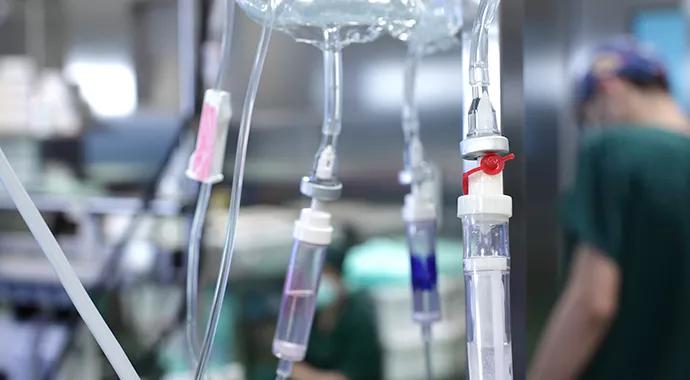Study finds no evidence that dual coverage lowers risk of surgical site infection

Surgical site infection (SSI) after nipple-sparing mastectomy (NSM) can be devastating for patients, potentially resulting in reconstruction failure. Aggressive use of antibiotics, however, is not associated with a reduced risk of infection, according to a new study.
Advertisement
Cleveland Clinic is a non-profit academic medical center. Advertising on our site helps support our mission. We do not endorse non-Cleveland Clinic products or services. Policy
Presented at the American Society of Breast Surgeons annual meeting, the retrospective analysis indicates that surgeons should focus on patient- and therapy-specific factors rather than trying to combat specific bacteria. Dual coverage for gram-positive organisms and other skin flora is unnecessary, say researchers from Cleveland Clinic.
“We thought that perhaps NSM could lead to a potential portal for infection and that perhaps administering broad-spectrum antibiotics would help decrease the risk for infection,” says Stephanie Valente, DO, a breast surgical oncologist and senior author on the study. “When we looked at outcomes in our population, however, we found that dual coverage or higher doses didn’t preclude patients from getting an infection. The deciding factors for risk appear to be body mass index (BMI), breast size, use of a tissue expander and exposure to adjuvant radiation therapy.”
The authors looked at outcomes in 347 patients (median age 48, 296 with a cancer diagnosis) who had undergone NSM with implant-based reconstruction (IBR) at Cleveland Clinic from 2010 to 2019. The information evaluated included patient characteristics, operative details and choice of perioperative antibiotic regimen. SSI incidence, management and causative organisms were analyzed.
During the study period, NSM with IBR was performed on 571 breasts. Of the NSMs, 73% were done through an inframammary incision. Of the IBRs, 55% were direct to implant, 45% tissue expander (TE)/implant, 64% were placed subpectoral and 36% prepectoral.
Advertisement
“We looked first at whether there were differences among the surgeons in terms of choice of procedure based on patient body habitus, BMI or breast cup size, but we found none,” says Dr. Valente. “TEs were more likely to be used in patients with cancer who might be receiving radiation, which had been a standard.”
Overall, 98% of patients received preoperative antibiotics, with 65% receiving single coverage cephalosporins, 12% single, broad coverage antibiotics and 20% dual coverage. Nearly all the patients (97%) were discharged on postoperative oral antibiotics, which were to be continued until drain removal.
The overall risk of an SSI during a 1.7-year follow-up period was 12%, with 6% of patients having a SSI that required implant removal.
Incidence of SSI was higher among cancer patients and patients in whom TE had been used than in those who had reconstruction with direct implants (15% vs 9%; P = 0.04). Development of SSI more than 90 days after surgery also was more likely in the patients with TEs (P < 0.001), and they were more likely to have received radiation (19% TE vs 7% implant).
“Our study demonstrates that surgeons placed TE rather than direct implants more frequently in patients with cancer who underwent axillary node dissection and for which postoperative radiation was needed. Knowing a patient will receive radiation is a risk factor which some surgeons anticipate at surgery and elect to place a TE in this setting while others choose to place DI, and this decision is multifactorial and an area of continued study,” says Dr. Valente.
Advertisement
The most common SSI bacteria identified requiring reoperative surgery was Staphylococcus. Although other more aggressive organisms were cultured, these were at a low frequency and not sufficient to justify routine use of broad or dual-coverage antibiotics.
“Even when cultures were sterile, some women went on to develop infection which required implant removal, which suggests that postoperatively, we should be treating patients based on symptoms in addition to culture,” says Dr. Valente. “Interestingly, in 38% of patients, the SSIs occurred more than 30 days after surgery, and late infections were associated with an increased risk of losing the implant.”
Neither incidence nor severity of SSI varied by antibiotic choice. Multivariate analysis showed that BMI ≥ 30 and exposure to radiation — but not antibiotic choice — were significant risk factors for developing SSI. In 25% of the patients who received radiation, reconstruction ultimately failed.
“In future studies, we would like to look at whether risk of SSI varies specifically for nipple-sparing versus skin-sparing mastectomy,” says Dr. Valente. “What we know from this study is that prescribing broad-spectrum antibiotics doesn’t reduce risk of SSI associated with NSM. Doing it adds costs and it also may expose our patients to increased risks of antibiotic resistance.”
Advertisement
Advertisement

National Blood Clot Alliance collaborates with faith-based organizations on first-of-its-kind church bus tour

AI-driven tools can streamline enrollment and improve efficiency across clinical trials.

Patient achieves complete remission from aggressive marginal zone lymphoma with liso-cel

Supporting patients during pregnancy and beyond

Real-world applications in clinical documentation and trial matching

Q&A with new classical hematology program leader

Patient with TP53 mutation achieves full response with targeted therapy

Concurrent treatment necessary for addressing progressive disease and infection